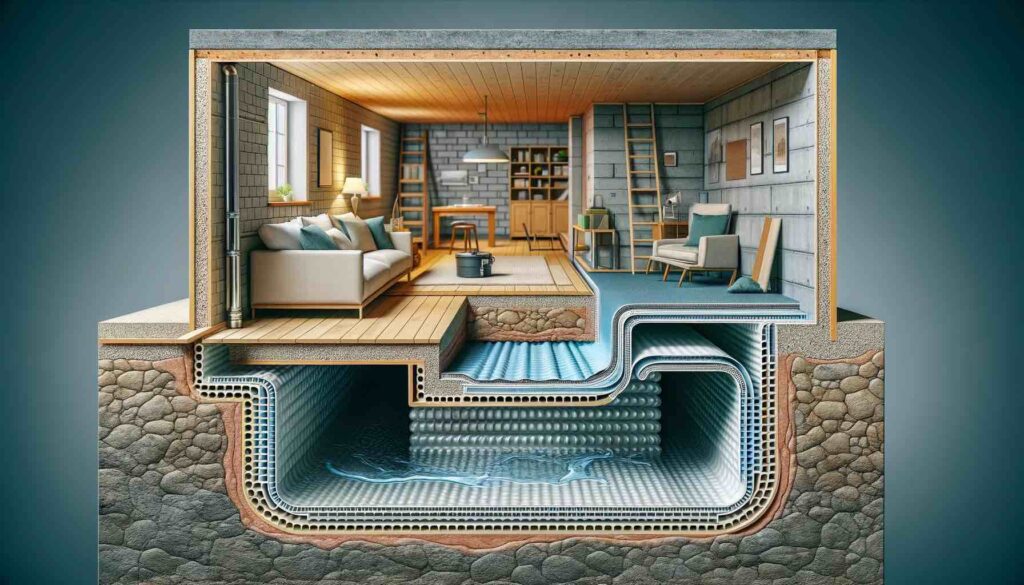Over thirteen yearsexperience in the industry
We can offer aMarket comparison
Accepted bymajority of high street banks
Recognised byUK Finance
Transforming Basements into Dry, Welcoming Spaces: The Essentials of Waterproofing
Creating a Habitable and Dry Basement Space
The primary goal of basement conversions is to extend your living space into a welcoming and, most importantly, dry area. The key to achieving this lies in effective basement waterproofing.
Methods of Basement Waterproofing
The process of waterproofing a basement includes blocking water entry. It can be achieved through various techniques such as:
- External Waterproofing: This method is typically implemented during the basement’s construction and relies on moisture-resistant building materials. However, its effectiveness is often only thoroughly tested once the surrounding soil settles, potentially revealing flaws under hydrostatic pressure.
- Cementitious Tanking Involves applying a bonded waterproof cement layer to the basement’s walls, floors, and sometimes ceilings. This layer, adhering to the masonry, creates a barrier against water, allowing breathability.
- Cavity Drain Membranes: These membranes form a gap between the wet wall and the waterproof layer, guiding any water ingress to a sump and pump system for evacuation.
Best Practices for Waterproofing a Basement
The most effective waterproofing approach considers the basement’s intended use and combines various waterproofing systems. Each method has its strengths and should be tailored to suit specific conditions.
Preparing for Waterproofing
Before waterproofing, ensure to:
- Clear the basement of all items.
- Thoroughly clean the area, removing debris and dust.
- Inspect and repair any wall damage.
 Choosing a Waterproofing Professional
Choosing a Waterproofing Professional
For optimal results, engage a professional specialising in basement waterproofing. Verify their credentials, focus on the guarantees offered, and consider if they are affiliated with organisations like the British Structural Waterproofing Association.
Enhancing Property Value with a Waterproof Basement
A waterproof basement prevents mould and rot and significantly increases property value. This added living space is particularly appealing in urban, high-value areas, especially London.
The Importance of BS8102 Compliance
All waterproofing systems should comply with the BS8102 guidelines. Familiarise yourself with these standards and the importance of sump pump maintenance and backup systems.
Waterproofing and Housing Considerations
A dry, welcoming basement property is more valuable and appealing to buyers than one with damp issues. Addressing waterproofing effectively can prevent long-term structural problems and make your property more attractive in the housing market.
Interior Drainage Systems
Interior drainage systems are crucial in basement waterproofing, especially in managing and redirecting water infiltration. Here’s an overview of how they work and why they are essential:
1. Functionality of Interior Drainage Systems:
- Interior drainage systems are designed to capture water that enters the basement, typically where the floor meets the walls, a common entry point for water.
- These systems consist of a drainage channel installed around the perimeter of the basement floor. The drain collects incoming water and directs it to a collection point, usually a sump pump.
2. Components of the System:
- Drainage Channel or Perimeter Drain: A trench is dug around the perimeter of the basement, and a drainage pipe or channel is installed. This pipe is perforated to allow water to enter and is often laid in a gravel bed to facilitate drainage.
- Sump Pump: The collected water is directed to a sump basin. When the water in this basin reaches a certain level, the sump pump activates and pumps the water out of the basement, typically discharging it away from the foundation.
- Vapour Barrier: Sometimes, a vapour barrier is also installed along the basement walls to direct wall seepage to the drainage channel.
3. Installation Process:
- Installing an interior drainage system typically involves some level of basement excavation. It may require the removal of a section of the basement floor along the perimeter and potentially the lower section of the basement walls.
- After installing the drainage channel and connecting it to the sump pump, the floor is restored, often with new concrete poured over the drainage system.
4. Advantages:
- Less Invasive: Compared to exterior waterproofing, interior drainage systems are less invasive and can be more cost-effective, as they don’t require excavating the entire outer perimeter of the house.
- Effective Water Management: They effectively manage water intrusion, redirecting it away from the basement living space.
- Reduced Hydrostatic Pressure: By capturing water at the point of entry, these systems help reduce hydrostatic pressure against the basement walls and floor, minimising the risk of structural damage.
5. Maintenance and Considerations:
- Regular maintenance of the sump pump and cleaning of the drainage channels is essential to ensure the system functions correctly.
- Battery backup systems for sump pumps are recommended to ensure functionality during power outages, which often accompany heavy storms.
6. Suitability and Limitations:
- Interior drainage systems are a practical solution for many basements but may only be suitable for some. Factors like the basement’s existing construction, soil conditions, and the water table level need to be considered.
- In cases of extreme flooding or severe foundational issues, additional waterproofing methods might be necessary.
Interior drainage systems offer an effective way to manage basement water issues, particularly with other waterproofing strategies. However, it’s crucial to assess each situation individually and consult with waterproofing professionals to determine the most appropriate solution for your basement needs. More on basement conversions.
Once the basement is waterproofed then it’s time to finish the basement.
For further information please contact Ed or Kelly on Tel: 01284 365345 or email ed@granitebw.co.uk / kelly@granitebw.co.uk.
Copyright © 2025 Granite Building Warranties
Supported by Fox 360 Ltd
Granite Building Warranties Ltd is an Appointed Representative of Richdale Brokers & Financial Services Ltd which is authorised and regulated by the Financial Conduct Authority.
Granite Building Warranties is a company registered in England and Wales (Company Number 11497543) with its registered office at 1st Floor, 5 Century Court, Tolpits Lane, Watford, WD18 9PX
